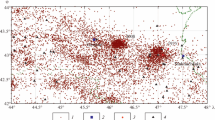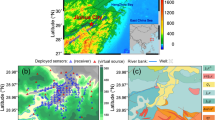Abstract
In regional seismic surveys use of small semipermanent networks of detectors is often made. This study aims at investigating qualitatively the location capability of networks constituted by four (bare minimum) sensors, arranged in different triangular configurations, which may be deployed in a region of known crustal structure. Their relative performances are evaluated on the basis of overall shifts in hypocentre, epicentre and origin time, these being computed by relocating a large number of assumed sources at three representative depths (0, 5 and 10 km) using an iterative method. Eight constructed examples, of which five pertain to sources lying outside a network and three pertain to sources contained within the outer boundaries of a network, provide data for the study. The influence of shape and size of a given network, on hypocentral determination, relative to the overall dimensions of the expected source region has been discussed.
It is shown that a right-angled triangle (three stations at the vertices and one near the centroid) with its equal orthogonal arms comparable in length with radial distance to epicenters is the best suited configuration for locating sources surrounding the network. Reducing network aperture is found to render the network performance poor. However, if the sources happen to be situated inside the network, the response of one type of network is not appreciably different from that of another but comparatively much better than that of any of the ‘source-outside’ configurations. Nevertheless, a right-angled triangle (three stations at the vertices and one near the centroid) enclosing the sources seems to be a marginally better choice. Notwithstanding network geometry, an increase in the number of detectors brings about a definite improvement in the estimates of source parameters. This is demonstrated by taking six stations instead of four. It is also shown that network performance remains practically invariant with shallow source depth. The location errors are inferred to be mainly due to the effect of crustal layering.
Similar content being viewed by others
References
Arora S K 1971Bull. Seism. Soc. Am. 61 671
Arora S K 1975Geophys. Res. Bull. 13 7
Blake W and Leighton F 1970Rock mechanics—theory and practice ed. W H Somerton (New York: Academic Press) 429
Bolt B A 1960Geophys. J. R. Astron. Soc. 3 433
Bolt B A and Turcotte F T 1964Computers in the mineral industry Part 2 ed. G Parks (Stanford Univ. Publ.)9 561
Bolt B A 1970Bull. Seism. Soc. Am. 60 1823
Crampin S 1970Geophys. J. R. Astron. Soc. 21 535
Crosson R S 1972Bull. Seism. Soc. Am. 62 1133
Douglas A 1967Nature London 215 47
Eatn J P, O’Neill M E and Murdock J N 1970Bull. Seism. Soc. Am. 60 1151
Engdahl E R and Gunst R H 1966Bull. Seism. Soc. Am. 56 325
Flinn E A 1960Bull. Seism. Soc. Am. 50 467
Gunst R H and Engdahl E R 1962Earthq. Not. 33 93
Hanks T C, Jordan T H and Minster J B 1971US Geol. Surv. Professional Paper 733 21
Herrin E, Taggart J and Brown Jr. C F 1962J. Grad. Res. Cent. 30 79
James D E, Sacks I S, Lazo L E and Aparico G P 1969Bull. Seism. Soc. Am. 59 1201
Kijko A 1977aPure Appl. Geophys. 115 999
Kijko A 1977bPure Appl. Geophys. 115 1011
Leighton F and Blake W 1970US Bur. Mines Rep. Invest. 7432 pp 18
Nordquist J M 1962Bull. Seism. Soc. Am. 52 431
Sato Y and Skoko D 1965Bull. Earthq. Res. Inst. 43 451
Sbar M L, Armbruster J and Aggarwal Y P 1972Bull. Seism. Soc. Am. 62 1303
Shapira A and Bath M 1977Seism. Inst. Uppsala Rep. 2/77 (Sweden) pp 24
Ward P L and Bjornsson S 1971J. Geophys. Res. 76 3953
Westphal W H and Lange A L 1967Bull. Seism. Soc. Am. 57 1279
Westphal W H and Lange A L January 1970Engg. Mining J. 86
Author information
Authors and Affiliations
Additional information
Deceased on 14th November 1977 at Manila in a fire accident when he was on a UNDP deputation.
Rights and permissions
About this article
Cite this article
Arora, S.K., Varghese, T.G. & Basu, T.K. Relative performance of different triangular networks in locating regional seismic sources. Proc. Indian Acad. Sci., A (E & P Sciences) 87, 271–281 (1978). https://doi.org/10.1007/BF02861522
Received:
Revised:
Issue Date:
DOI: https://doi.org/10.1007/BF02861522




